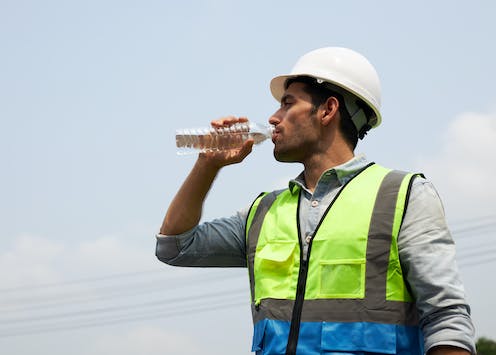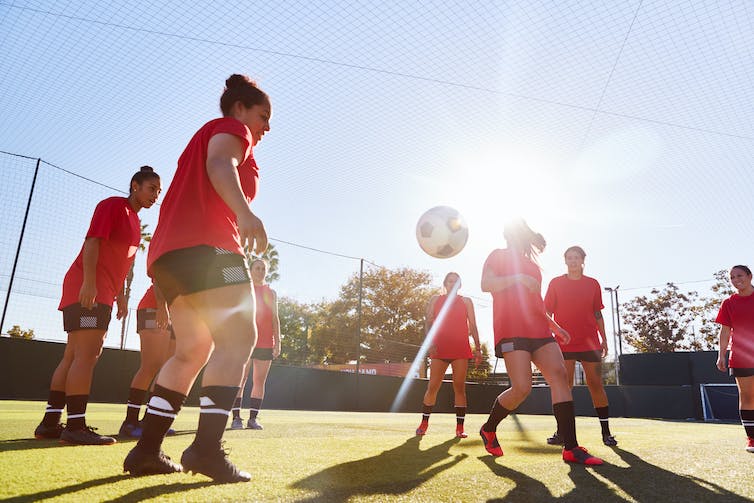
(Shutterstock)
Global warming is making outdoor activities challenging — especially exercise. Indeed, we have a very small buffer to tolerate an increase in body heat. A rise in core temperature of only three degrees Celcius can be life-threatening, even for young healthy adults.
There are several ways to help prevent a perilous rise in core temperature while being physically active in the heat. There are numerous pre-cooling strategies that can help. Most practical of those is consuming a cold drink (or better yet, an ice slurry or slushie) prior to exercise. But “training” your body to cope better in the heat is the best defence.
The strategy of heat training is particularly important for endurance athletes. Athletes who incorporate even a modest heat acclimating protocol before competing in the heat on average perform better and are less likely to require medical attention for heat-related injuries.
However, given our warming environment, it may be time to consider heat training even for non-athletes, especially for people working outdoors.
While heat acclimation training is most often used by endurance athletes, it was first developed for underground gold mine workers in the 1940s, who were exposed to environmental temperatures exceeding 50 C with humidity near 100 per cent.
Table of Contents
How does heat acclimation help?

(Shutterstock)
The benefits of heat acclimation are a growing area of research. In fact, the benefits seem to extend beyond being more heat tolerant, and into improvements for general cardiovascular health — known as heat therapy.
For improvements in heat tolerance, however, the primary benefits are quite simple:
-
It lowers our resting body temperature, which provides a larger reserve for our core temperature to rise before problems occur.
-
It increases our sweating rate, which optimizes our evaporative heat loss potential, thereby attenuating the rise in core temperature.
-
It increases our plasma volume (the liquid part of blood), which lowers the cardiovascular strain imposed by a rise in core temperature, and provides a larger reserve to maintain sweat rate (sweat comes from plasma).
In addition to these three factors is an improved perception of thermal comfort. There are also other more nuanced benefits for improved heat tolerance, including salt conservation, metabolic and anti-inflammatory effects, but the three listed above are most important.
Methods of heat acclimation
Heat acclimatization and heat acclimation are slightly different: It is called heat acclimatization when it occurs naturally over a longer period, and heat acclimation when done “artificially” or purposefully over a shorter duration. Both forms confer benefits for heat tolerance, but they are not entirely synonymous.

(Shutterstock)
Heat acclimatization can, and does to some extent, occur naturally in people who are constantly exposed to hot and humid environments. But for those of us living in a humid continental climate (which includes most populated regions above the 40th parallel), or for those who usually seek air-conditioning in the summer, natural heat acclimatization rarely occurs. It takes a bit of work.
The degree of heat adaptation depends on the duration, intensity and frequency of heat exposure.
The gold standard for heat acclimation involves maintaining an elevated core temperature by one to two degrees Celcius for at least 60 minutes, for a minimum of five consecutive days, or over a two-week period allowing for a few rest days. But importantly, the biggest adjustments occur within the first few days, and begin to have a ceiling effect around two weeks, with minor benefits thereafter.
The benefits of heat acclimation for improved heat tolerance unfortunately don’t last forever. They are largely retained for approximately one week following the last heat exposure, but approximately 75 per cent of the benefits will be lost after three weeks without any heat exposure. Thankfully re-acclimatization is generally easier, and a “steady state” heat acclimated status can be achieved by maintaining some form of heat exposure at least three times per week.
At-home heat acclimation
For those without access to a heat chamber or thermistor (for example an ingestible internal thermometer) to monitor your body’s core temperature, heat acclimation is still possible. All you need is a tub.
A recent study suggests that an effective (and practical) protocol for partial but meaningful heat acclimation is simply three consecutive days of soaking in 40 C water for about 40 minutes, immediately after about 40 minutes of moderate-intensity exercise at room temperature.

(Shutterstock)
The key is that the exercise must be strenuous enough to bring your body temperature past a threshold for sweating, and that you immediately enter the tub after the exercise. According to the study’s authors: “Taking a hot bath submerged to the neck, for up to 40 minutes, following habitual training in temperate conditions, presents a practical and economical heat acclimation intervention — eliminating the requirement for an increased training load, access to an environmental chamber or relocation to a hot climate.”
Ultimately, strategies to avoid excessive heat exposure are still paramount, especially for those who are more vulnerable to heat-related injuries, including older adults and people with conditions such as heart disease and diabetes.
But it is becoming increasingly apparent that heat exposure is inevitable for those who work or are active outdoors. Incorporating a heat acclimation protocol, in combination with the more recognized heat-mitigating strategies — including sun protection and maintaining hydration — provides your body with the best defence against heat-related injuries.
![]()
Anthony Bain does not work for, consult, own shares in or receive funding from any company or organization that would benefit from this article, and has disclosed no relevant affiliations beyond their academic appointment.






















